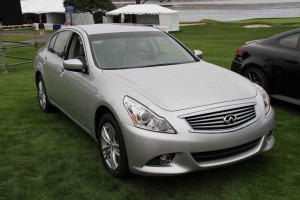
Over 1,300 Infiniti vehicles were destroyed at one Japanese port. The G25 is shown here, though it's not clear which models were ruined.
Automotive stocks are being battered by twin crises at opposite ends of the world. Just how long things will continue to worsen – and how bad they will get – is almost impossible to predict, industry analysts are warning.
But investors aren’t the only ones who could soon feel the impact. The Libyan crisis has already taxed on what some call a “crisis tax” to what U.S. motorists are paying at the pump. The Japanese earthquake and tsunami will almost certainly have at least some impact on the availability of products from makers like Toyota, Nissan and Honda. And that could translate into not only waiting lines but higher prices, observers warn.
It was not a good day for Wall Street, overall, the Dow Jones Industrial Average slipping below 12,000 points for the first time in nearly two months. But automotive stocks were particularly hard hit by concerns about oil prices, the Japanese disaster – and the threat of a weakened economy. General Motors, which last week saw shares dip below its $33 IPO price, slipped another 34 cents, to $31.59, at the closing bell.
Ford was down, as well, as were all the Japanese makers. Toyota lost $3.92, closing at $81.73 on the New York Stock Exchange, a big blow for a stock that had only recently begun to stage a serious recovery from the impact of its long-running safety scandal.
What’s disconcerting is that “no one knows” whether things will turn around soon, cautions Joe Phillippi, a long-time Wall Street investment analyst and now director of AutoTrends Consulting.
If anything, the crisis in Libya is only heating up, rebels suddenly losing ground to reinvigorated government forces. World leaders have yet to form clear consensus on what, if anything to do in response.
But, for now, the real concern is the impact of the Japanese earthquake and subsequent tsunami. All of the country’s carmakers have put production operations on hold as they assess damage. Honda so far appears to have been the only maker to actually suffer the death of a worker on one of its sites, but numerous auto plants have apparently taking at least some damage.
That is expected to be matched by industry suppliers, who will have to get their own facilities back in operation before automotive assembly lines can get up and running again. Japanese automakers are strict adherents of just-in-time production methods, which means they have little to no inventory to draw from. (For more on the impact on Japanese automakers, Click Here.)
Thousands of vehicles appear to have been lost at ports across the country. That reportedly included 1,300 Infiniti vehicles that were being held at the port Hitachi. Currently, all of the models sold by Nissan’s luxury division are produced in home market plants.
Various sources suggest that even a short shutdown could result in the loss of anywhere from 100,000 to more than a quarter million Japanese-made vehicles. That could lead to shortages of some products — such as Infiniti models, the subcompact Honda Fit and Toyota Yaris and others – earmarked for the American market.
But U.S. motorists could also feel the impact even with vehicles produced in North American “transplant” assembly lines, suggested George Peterson, chief analyst with AutoPacific, Inc. Part of the problem is that, while those transplants produce more than half the Japanese-badged vehicles sold in North America, they still depend on many parts imported from Japan.
“Even if they have one widget sole-sourced from (produced only in) Japan, their American assembly plants could come to a halt.”
The impact on those transplants will likely take longer to come, but could also last longer. While facilities like the Honda plant in East Liberty, OH, also are Just-in-Time, there’s a lag time between Japanese suppliers and the U.S., parts often spending weeks crossing the ocean.
As a result, “I expect the real disruptions” in North America “won’t be felt until the beginning of April,” warned analyst Peterson.
Though Japanese makers are the most likely to see disruptions, he added, American makers also use Japanese components, and if they don’t have alternative plans they could see some of their operations disrupted, as well.
For investors, the result would be felt on the bottom line, and earnings very well could also be seriously impacted by the need to rebuild costly factories, some of which run to more than $1 billion if they had to be replaced.
For shoppers, the coming weeks, perhaps months, could see shortages of some popular products, though it’s too early to determine which.
What’s also unclear is whether that would impact pricing. Two decades ago, analysts blame so-called “voluntary” import restraints with not only creating a shortage of some Japanese models but also for running up prices.
That supply-and-demand rule could come into play for Japanese products, suggested Phillippi.
Though he expressed his hopes that dealers will “shy away from” taking advantage of the situation, “There is always a cohort of dealers who never let a good crisis go to waste. They will attempt to take advantage” of the situation by charging premiums if they believe anxious customers will be willing to pay.
